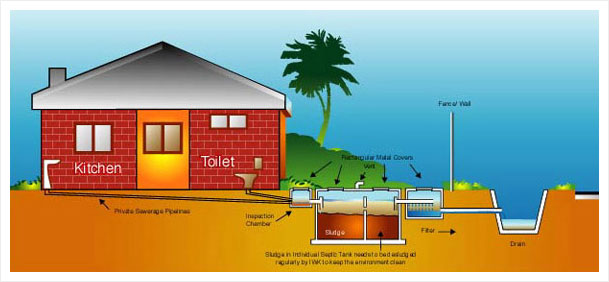Definition of waste water and sewage
(a) Waste Water- is any water that has been adversely affected in quality by anthropogenic influence.
(b) Sewage - a water-carried waste, in solution or suspension, that is intended to be removed from a community such as from domestic or municipal wastewater.
(source: http://sewagetreatment.us/sewage-treatment/sewage-water-sludge-sullage-excreta-sources-waste-water/)
Sewage content:
(a) Organic matter
(b) Nutrients (Nitrogen, Phosphorus, Potassium)
(c) Inorganic matter (dissolved minerals)
(d) Toxic chemicals (heavy metal and pesticides)
(e) Pathogens
Sewage Water Treatment:
The main purpose of water treatment:
- To produce a disposable effluent without causing harm to the surrounding environment and prevent pollution.

(source: https://www.halifax.ca/harboursol/WWTFinformation.php)
Individual Septic Tank
- It only provides partial sewage treatment that flows into it and needs to be desludged approximately once in two years.
- Premises with a proper individual septic tank (Malaysian Standards -MS 1228 ) has 3 to 4 rectangular metal covers and is usually located outside the premises.

(source: https://www.iwk.com.my/customer/individual-septic-tank)
Why sewage treatment is important?
(a) To improving the environment through proper drainage and disposal of wastewater;
(b) To preventing floods through removal of rainwater;
(c) To preserving receiving water quality.
Sludge:
- Sludge is the accumulated solids produced by a waste water treatment plant and solids left from septage, the liquid pumped from septic tanks.
(source: http://www.gasregister.co.uk/faq/text/additional/What%20is%20sludge/1038/index.htm)
Effluent discharge:
- Must be accomplished without transmitting diseases, endangering aquatic organisms, impairing the soil, or causing unsightly or foul-smelling conditions.
- Effluent standards define what is allowed within the waste waters discharged into the aquatic environment.
- 2 most important parameters are:
(a) Biochemical Oxygen Demand (BOD):
- The amount of oxygen that sewage consumes over a given time. High BOD means, sewage rapidly consume all the naturally-dissolved oxygen in streams, rivers and lakes, thus killing off all aquatic life.

(source: http://prepareias.in/subject/gs/ecology-and-environment/-biochemical-oxygen-demand)
(b) Suspended Solids (SS):
- The undissolved material in sewage. High SS leads to sludge deposits in the waterways, thus causing significant environmental deterioration.
(source: http://www.fondriest.com/environmental-measurements/parameters/water-quality/turbidity-total-suspended-solids-water-clarity/)
What if it is not treated well?
(a) Health Effects:
- It will contaminate from inhalation, ingestion, or direct contact to human by chemical, microbiological and biological properties of the sewage or sludge.
- The Centers for Disease Control and Prevention (CDC) says sewage workers are not at more risk of Hepatitis A infection than other workers.
- The sewage contain bacteria, fungi, parasites, and viruses that can cause intestinal, lung, and other infections.
- Bacteria such E. coli, shigellosis, typhoid fever, salmonella, and cholera may cause diarrhoea, fever, cramps, and sometimes vomiting, headache, weakness, or loss of appetite.
(b) Environmental Effects:
- Sewage with high concentrations nutrients can be responsible for the formation of algal blooms which reduce light penetration through the water column, may produce toxins and can cause oxygen depletion when decomposition takes place.
Guideline and Legislation
•Environmental Quality (Sewage) Regulations 2009
•Environmental Quality (Industrial Effluent) Regulations 2009
References:
None of the point is mine, you can refer it at the below:
-Delaware Health & Social Services, 2011. Division of Public Health.
- McGraw-Hill Concise Encyclopedia of Engineering. © 2002 by The McGraw-Hill Companies, Inc.
- Morgan, M.T. (Ed). 2003. Environmental Health. 3rdEdition. Thomson Wadworth. Australia
- W.H. Bassett, 2004. Clay’s Handbook of Environmental Health. Nineteenth edition.
- Howard Frumkin, 2005. Environmental Health. From Global to Local.
-UK Marine Special Areas of Conservation. Sewage
- https://en.wikipedia.org/wiki/Wastewater
- https://en.wikipedia.org/wiki/Sewage
http://www.unep.or.jp/Ietc/Publications/Freshwater/FMS10/2importance.asp
- http://www.txpeer.org/toxictour/what_is_sludge.html
No comments:
Post a Comment